Class 8 Exam > Class 8 Notes > NCERT Textbooks & Solutions for Class 8 > NCERT Summary: Cell - Structure & Functions
Cell - Structure & Functions Summary Class 8 NCERT Summary
Cell
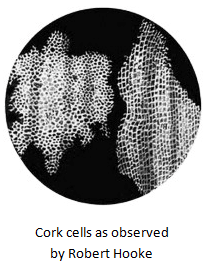
Discovery of the Cell
- Cells are the fundamental units that make up all living organisms.
- The cell was first identified by Robert Hooke in the year 1665 when he observed a slice of cork under a microscope.
- During his observations, Hooke coined the term "cell" to describe these tiny units of life.
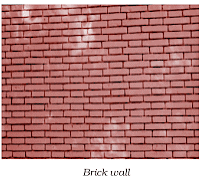
Cell Theory
- Schleiden and Schwann proposed the cell theory.
- According to cell theory: Cells are the basic structural and functional units of life.
- All living organisms are made up of one or more cells.
- New cells arise from pre-existing cells.
Types of Organisms on the basis of cell
1. Unicellular organisms
- Unicellular organisms are those that consist of a single cell, such as Amoeba and Paramecium.
- In these organisms, all vital functions like digestion, respiration, and excretion are performed by that one cell.
2. Multicellular organisms
- Multicellular organisms are made up of more than one cell, such as humans, cows, and roses.
- In these organisms, cells are specialized for different functions, with specific cells taking on particular roles.
Shape of the Cells
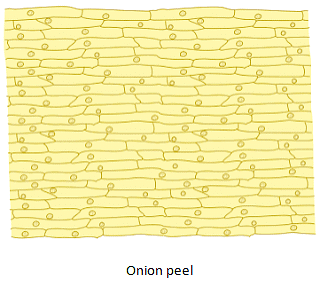
- Most of the cells have a definite shape.
- Some cells such as that in Amoeba have no definite shape.
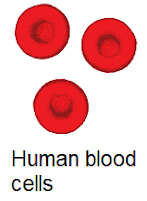
- The human red blood cell (RBC) is spherical-shaped.
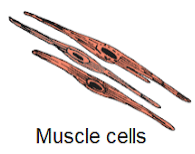
- The muscle cells in humans are spindle-shaped.
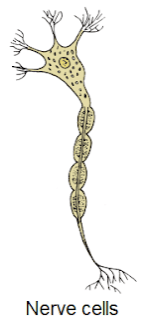
- The human nerve cells have elongated branched structure.
- In plants and bacteria, the cell is enclosed in a protective covering called cell wall, which gives shape and rigidity to the cells.
Size of the Cells
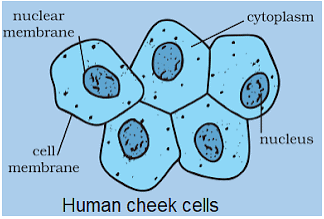
- The smallest cells in bacteria range from 0.1 to 0.5 micrometres in size.
- The largest cells, like an ostrich's egg, can measure around 170 mm x 130 mm.
- While there is some link between cell size and the size of the organism, it is not a strict correlation.
Cell Structure and Functions
- In multicellular organisms, each organ system is made up of multiple organs.
- Organs, in turn, are composed of tissues.
- Tissues consist of groups of similar cells that work together to perform a specific function.
- Organisms with only one cell are called unicellular organisms. Examples include Amoeba and Paramecium.
- In unicellular organisms, a single cell carries out all essential functions like digestion, respiration, and excretion.
- Organisms with more than one cell are known as multicellular organisms. Examples include Humans and Cows.
- In multicellular organisms, cells specialize in different tasks, showing a division of labor. Each type of cell is responsible for specific functions in the body.
Types of cell
There are two types of cells:
- Prokaryotic cells: These cells lack a well-defined nuclear membrane. The genetic material is dispersed throughout the cytoplasm. Examples include bacteria and cyanobacteria.
- Eukaryotic cells: These cells possess a nucleus enclosed by a distinct nuclear membrane. Examples include plant and animal cells.
Components of the cell
Cell membrane
- It is the protective layer that surrounds the cell.
- Cell membrane selectively allows the entry of only some substances and prevents the movement of other materials.
- Hence, it checks the transport of substances in and out of the cell.
Cell wall
- In plants, an extra protective covering of a polysaccharide, cellulose is present.
- It is called cell wall that protects plant cells from environmental variations.
Cytoplasm
- It is a jelly-like substance present between cell membrane and nucleus.
- It contains various cell organelles such as mitochondria, Golgi bodies, lysosomes etc.
Nucleus
- It is a dense spherical body located at the centre of the cell.
- It is surrounded by porous nuclear membrane.
- It contains spherical body called nucleolus.
- It also contains thread-like structures called chromosomes.
Chromosomes
- These are the structures that carry genes and play an important role in inheritance.
- Genes are the structural and functional unit of inheritance.
- The entire living substance in a cell is known as protoplast.
Vacuoles
- Vacuoles are fluid-filled membrane-bound structures in the cell.
- In plant cells, a single large vacuole is present.
- In animal cells, numerous small vacuoles are present.
- The membrane of the vacuole is called tonoplast.
- This membrane encloses a fluid called cell sap.
Plastids
- They are present only in plant cells.
- Plastids that contain green colour pigment chlorophyll are known as chloroplasts.
- It is the chlorophyll that gives green colour to the leaves.
- Chloroplast traps solar energy and utilizes this energy to manufacture food for the plant.
Plastids are of two types:
(i) Leucoplasts
(ii) Chromoplasts
- Leucoplasts are colourless and are used to store food while chromoplasts are plastids containing pigments.
- Chloroplasts are a type of chromoplasts.
Chloroplasts consist of two regions:
(i) grana (stacks of sac like membrane bound structures that contain pigment chlorophyll)
(ii) stroma (ground substance containing enzymes and starch grains)
Endoplasmic Reticulum (ER)
(i) Rough Endoplasmic Reticulum (RER): It is important for the synthesis and packaging of proteins.
(ii) Smooth Endoplasmic Reticulum (SER): It acts as storage organelle. It also helps in lipid (fat) synthesis.
Golgi Apparatus
- It is made up of parallel arranged membrane-bound vesicles called cisternae.
- It helps in storage, modification, and packaging of products in vesicles.
- It helps in formation of glycoproteins and glycolipids.
Lysosomes
- It is a membrane-bound structure that holds variety of enzymes.
- Rich in all types of hydrolytic enzymes, which are active at acidic pH.
- It is involved in the digestion of carbohydrates, proteins, lipids, and nucleic acids.
Mitochondria
- It is a double membrane-bound structure.
- The inner membrane of mitochondria is deeply folded to form cristae.
- Cristae increase the surface area in the organelle.
- It is the site of cellular respiration and hence known as ‘power house of cell’.
- They have their own circular DNA.
- They divide by fission.
Differences between plant and animal cells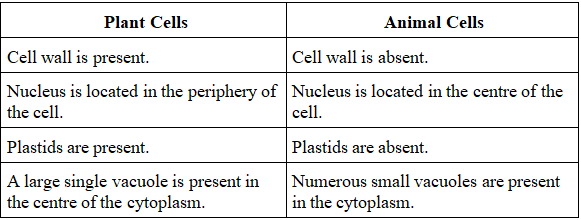
Diagram of Plant Cells and Animal Cells
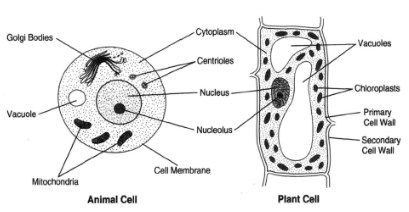
The document Cell - Structure & Functions Summary Class 8 NCERT Summary is a part of the Class 8 Course NCERT Textbooks & Solutions for Class 8.
All you need of Class 8 at this link: Class 8
FAQs on Cell - Structure & Functions Summary Class 8 NCERT Summary
| 1. What are the main components of a cell? |  |
Ans.The main components of a cell include the cell membrane, cytoplasm, nucleus, and various organelles such as mitochondria, endoplasmic reticulum, Golgi apparatus, lysosomes, and ribosomes. Each of these components plays a crucial role in maintaining the cell's functions and overall health.
| 2. What is the function of the cell membrane? |  |
Ans.The cell membrane serves as a protective barrier that surrounds the cell, controlling the movement of substances in and out of the cell. It is selectively permeable, allowing essential nutrients to enter while keeping harmful substances out. Additionally, it helps in cell communication and signaling.
| 3. How do plant cells differ from animal cells? |  |
Ans.Plant cells differ from animal cells in several ways: they have a rigid cell wall made of cellulose, chloroplasts for photosynthesis, and large central vacuoles for storage and maintaining turgor pressure. Animal cells, on the other hand, do not have cell walls or chloroplasts and typically have smaller vacuoles.
| 4. What is the role of mitochondria in the cell? |  |
Ans.Mitochondria are known as the powerhouse of the cell because they produce adenosine triphosphate (ATP), which is the main energy currency of the cell. They also play a role in regulating cellular metabolism and are involved in processes such as the citric acid cycle and oxidative phosphorylation.
| 5. What are ribosomes and what is their function? |  |
Ans.Ribosomes are small, complex structures found within cells that are responsible for protein synthesis. They read messenger RNA (mRNA) and translate it into polypeptide chains, which then fold into functional proteins. Ribosomes can be found free-floating in the cytoplasm or attached to the endoplasmic reticulum.
Related Searches
















